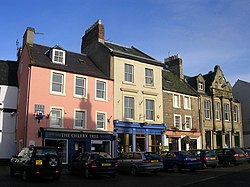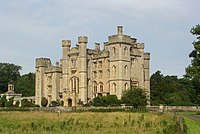Duns: Difference between revisions
Created page with '{{Infobox town | name= Duns | county = Berwickshire | picture=Duns from Duns Law.jpg | picture caption=Duns from Duns Law | latitude=55.77838 | longitude=-2.3426 | population = …' |
mNo edit summary |
||
| (One intermediate revision by one other user not shown) | |||
| Line 2: | Line 2: | ||
| name= Duns | | name= Duns | ||
| county = Berwickshire | | county = Berwickshire | ||
| picture=Duns | | picture=Duns Town Centre - geograph.org.uk - 240701.jpg | ||
| picture caption=Duns | | picture caption=Duns town centre | ||
| latitude=55.77838 | | latitude=55.77838 | ||
| longitude=-2.3426 | | longitude=-2.3426 | ||
| Line 14: | Line 14: | ||
| dialling code= 01361 | | dialling code= 01361 | ||
}} | }} | ||
'''Duns''' is a town in [[Berwickshire]]. It was created a burgh of barony in 1490 by King James IV, and is Berwickshire's [[county town]]. | '''Duns''' is a town in [[Berwickshire]]. It was created a burgh of barony in 1490 by King James IV, and is Berwickshire's [[county town]]. | ||
Duns has the largest shopping facilities in a radius of 15 miles and houses the Berwickshire Sheriff Court as well as principal offices of the Scottish Borders Council. Since the early 1990s Duns and its immediate vicinity have seen substantial housing development, some controversial. A development near the golf club on the road to [[Longformacus]] just outside Duns is one such example, as it was built upon [[green field]] sites. Opposite the Berwickshire High School a new modern High School has been constructed to replace the mid-1950s buildings in which the school was previously housed. The new High School opened in February 2009. | Duns has the largest shopping facilities in a radius of 15 miles and houses the Berwickshire Sheriff Court as well as principal offices of the Scottish Borders Council. Since the early 1990s Duns and its immediate vicinity have seen substantial housing development, some controversial. A development near the golf club on the road to [[Longformacus]] just outside Duns is one such example, as it was built upon [[green field]] sites. Opposite the Berwickshire High School a new modern High School has been constructed to replace the mid-1950s buildings in which the school was previously housed. The new High School opened in February 2009. | ||
==Castle== | ==Castle== | ||
[[File:Duns Castle.jpg|left|200px|thumb|Duns Castle]] | |||
The feudal Laird are Alexander Hay of Duns and Drumelzier. His family acquired Duns Castle by marriage in 1696, and were responsible for the present Gothic Revival structure; before that, it had been a substantial peel tower built in 1320 by the Earl of Moray who had been granted the estate by Robert I. | The feudal Laird are Alexander Hay of Duns and Drumelzier. His family acquired Duns Castle by marriage in 1696, and were responsible for the present Gothic Revival structure; before that, it had been a substantial peel tower built in 1320 by the Earl of Moray who had been granted the estate by Robert I. | ||
| Line 40: | Line 38: | ||
==The Ba game of Duns== | ==The Ba game of Duns== | ||
This is a kind of | This is a kind of mediæval football. Three balls or "Ba"s were required for this game; the first was gold, the second silvered, and the third coloured or spotted. A fourth was provided in case of mishap, and if not needed was presented to the subscriber whose entertainment had been most hospitable, the Hay family at Duns Castle usually being the recipients. | ||
At mid-day the honour of throwing up the ball would be auctioned in the Kirkyard. The throw would invariably be performed by a member of the Duns Castle family. At 1 o'clock the game began, the Ba being thrown up in the Market Square. The goal for the married men was the pulpit of the church; if a goal was scored then the church bell would rung by the victors. The goal of the bachelors was the hopper of any of the grinding mills in the district, the nearest being over a mile away. If a bachelor won the Ba he would be dusted with flour and receive a meal of pork and dumplings from the miller.<ref>http://www.dunsehistorysociety.co.uk/bagame2.shtml</ref> | At mid-day the honour of throwing up the ball would be auctioned in the Kirkyard. The throw would invariably be performed by a member of the Duns Castle family. At 1 o'clock the game began, the Ba being thrown up in the Market Square. The goal for the married men was the pulpit of the church; if a goal was scored then the church bell would rung by the victors. The goal of the bachelors was the hopper of any of the grinding mills in the district, the nearest being over a mile away. If a bachelor won the Ba he would be dusted with flour and receive a meal of pork and dumplings from the miller.<ref>http://www.dunsehistorysociety.co.uk/bagame2.shtml</ref> | ||
Latest revision as of 11:47, 11 October 2010
| Duns | |
| Berwickshire | |
|---|---|
 Duns town centre | |
| Location | |
| Grid reference: | NT786539 |
| Location: | 55°46’42"N, 2°20’33"W |
| Data | |
| Population: | 2,594 |
| Post town: | Duns |
| Postcode: | TD11 3xx |
| Dialling code: | 01361 |
| Local Government | |
| Council: | Scottish Borders |
| Parliamentary constituency: |
Berwickshire, Roxburgh and Selkirk |
Duns is a town in Berwickshire. It was created a burgh of barony in 1490 by King James IV, and is Berwickshire's county town.
Duns has the largest shopping facilities in a radius of 15 miles and houses the Berwickshire Sheriff Court as well as principal offices of the Scottish Borders Council. Since the early 1990s Duns and its immediate vicinity have seen substantial housing development, some controversial. A development near the golf club on the road to Longformacus just outside Duns is one such example, as it was built upon green field sites. Opposite the Berwickshire High School a new modern High School has been constructed to replace the mid-1950s buildings in which the school was previously housed. The new High School opened in February 2009.
Castle

The feudal Laird are Alexander Hay of Duns and Drumelzier. His family acquired Duns Castle by marriage in 1696, and were responsible for the present Gothic Revival structure; before that, it had been a substantial peel tower built in 1320 by the Earl of Moray who had been granted the estate by Robert I.
Country Houses
The district surrounding Duns once had a considerable number of famous Country Houses. Those surviving include:
- The Edwardian mansion Manderston House (rebuilt in 1903), which lies just outside the burgh on the A6105 road to Berwick-upon-Tweed, the home of a Liberal peer, Lord Palmer.
- The early 18th century Edrom House (after architect James Smith), 2 miles east of Manderston and now the home of the supermodel Stella Tennant.
- About a mile east of Edrom stands Blanerne Castle, an ancient seat of the Lumsden family, rebuilt by architect William Burn in 1895 following a fire. Its ruined mediaeval pele Tower stands nearby.
- Nisbet House (c. 1630) with its great tower (1774) is about 1½ miles south of the town, and is currently being restored as a private home.
- Wedderburn Castle (1771-1775, by architects Robert Adam and James Adam is 2 miles east of Duns and is built on the site of the earlier Tower house. It is the seat of the Homes of Wedderburn.
- Further south lies Kimmerghame House, a Scottish Baronial mansion completely rebuilt in 1851 by architect David Bryce, almost destroyed by fire in 1938 but again much rebuilt. It is now the seat of a former Lord Lieutenant of Berwickshire, Major-General Sir John Swinton (father of the actress Tilda Swinton).
The Ba game of Duns
This is a kind of mediæval football. Three balls or "Ba"s were required for this game; the first was gold, the second silvered, and the third coloured or spotted. A fourth was provided in case of mishap, and if not needed was presented to the subscriber whose entertainment had been most hospitable, the Hay family at Duns Castle usually being the recipients.
At mid-day the honour of throwing up the ball would be auctioned in the Kirkyard. The throw would invariably be performed by a member of the Duns Castle family. At 1 o'clock the game began, the Ba being thrown up in the Market Square. The goal for the married men was the pulpit of the church; if a goal was scored then the church bell would rung by the victors. The goal of the bachelors was the hopper of any of the grinding mills in the district, the nearest being over a mile away. If a bachelor won the Ba he would be dusted with flour and receive a meal of pork and dumplings from the miller.[1]
The game was revived in 1949 as part of the Duns Summer Festival. The goals are now at opposite corners of the Market Square, by the White Swan hotel and the Post Office.
The town is popular with walkers, many of whom scale the Duns Law (hill).
References
- Strang, Charles Alexander, Borders and Berwick, Rutland Press, 1994, (P/B), ISBN 1-873190-10-7